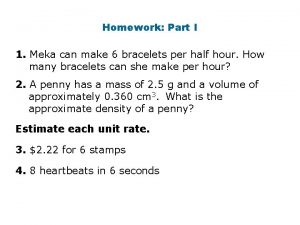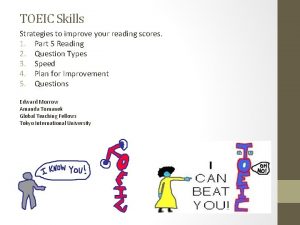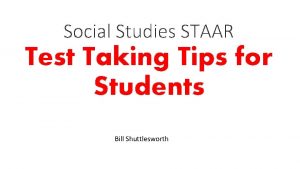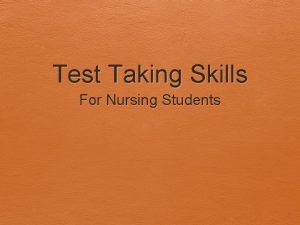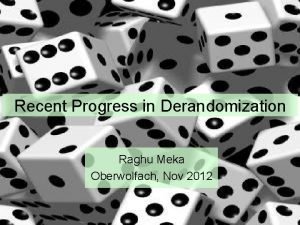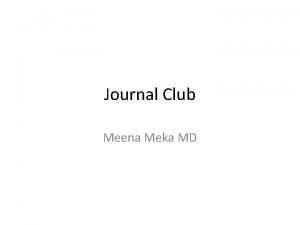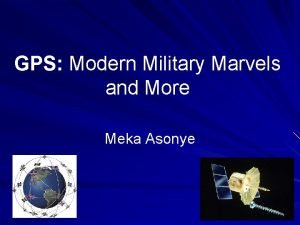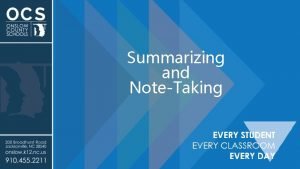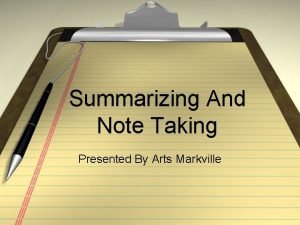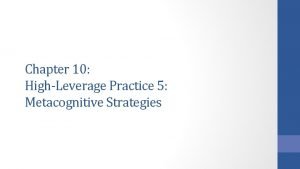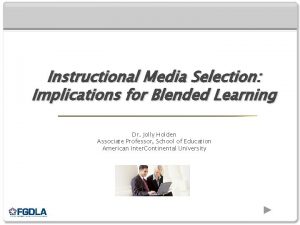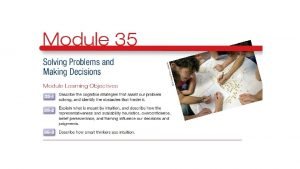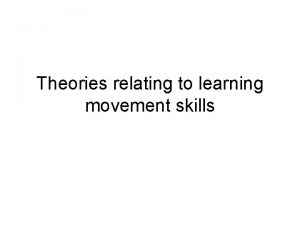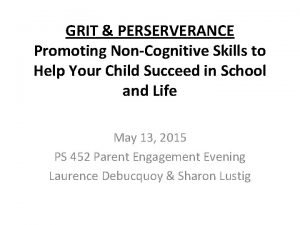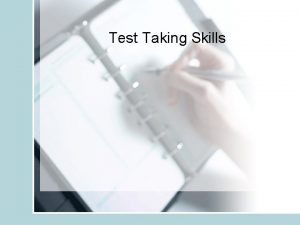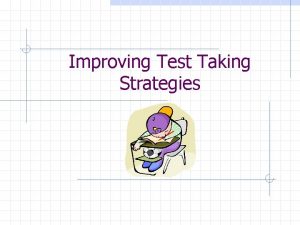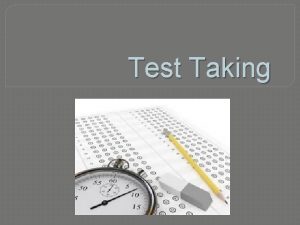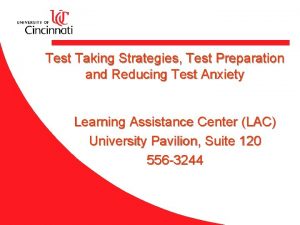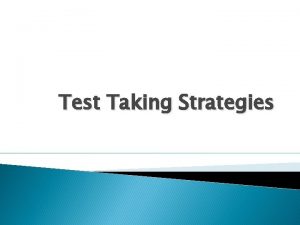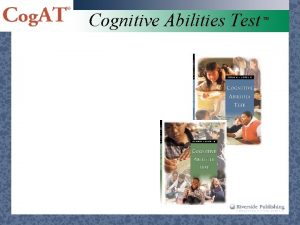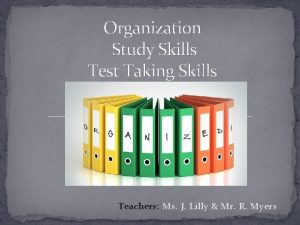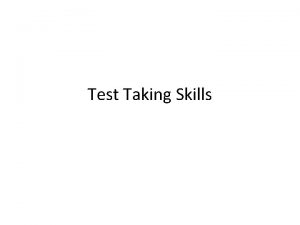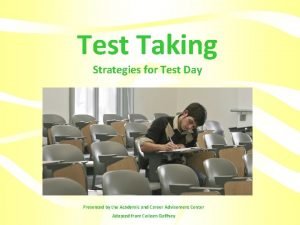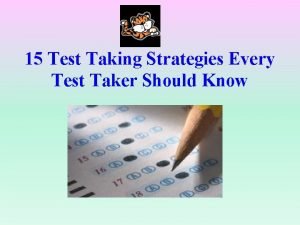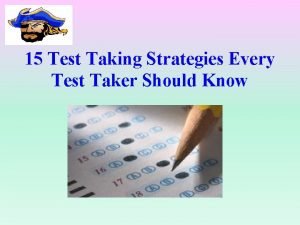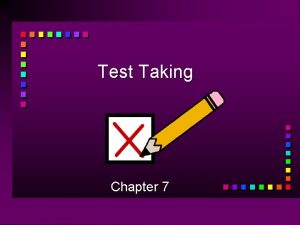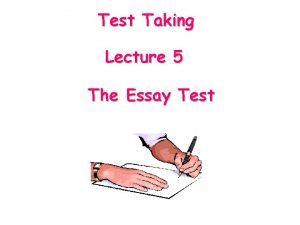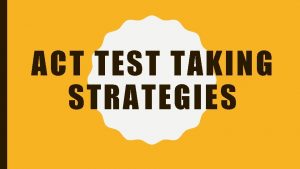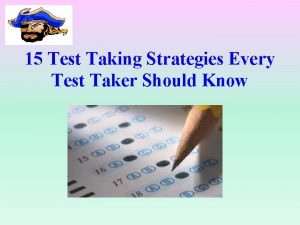TEST TAKING STRATEGIES Cognitive Skills Program Jennifer Meka

























- Slides: 25

TEST TAKING STRATEGIES Cognitive Skills Program Jennifer Meka, Director Email: jmeka@hmc. psu. edu Phone: 717 -531 -0003 ext. 287646

General Recommendations for MC Questions • assemble key clues into a mental "snapshot" of the patient • understand precisely what is being asked • allow a few moments to think, recall, and to anticipate possible answers • compare the given choices to your anticipated answer • mark choices that match best • rule out choices that don't account for all findings • mark the best answer

Errors to Avoid • Answering a question that is not being asked • Focusing on an irrelevant fragment of the question • Not identifying important sections of the question • Focusing on the answer choices/options

MC Question Approach Steps 1 & 2: Read and Paraphrase 1. Read the last sentence or two of the question vignette (the actual question) first. This will help you know what to look for in the vignette to answer the question. 2. Read the rest of the question (vignette). Before you look at the answer options, stop to paraphrase the case and question.

Try it out: Read and Paraphrase A 75 -year-old smoker and alcohol abuser is hospitalized for evaluation of a squamous cell carcinoma of the larynx. On his second hospital day, he complains of sweating, tremors, and vague gastrointestinal distress. On physical examination, he is anxious and has a temperature of 101°F, heart rate of 104/min, BP of 150/100 mm Hg, and a respiratory rate of 22 breaths per minute. Later that day, he has three generalized tonic-clonic seizures. Which of the following is the most likely cause of his seizures?

Remember: Read & Paraphrase 1. Read the last sentence or two of the question vignette (the actual question) first. *Share: What do you need to look for? 2. Read the rest of the question (vignette). Stop to paraphrase the case and question. *Share: What are the key aspects of this case?

MC Question Approach Step 3: Predict 1. Read the last sentence or two of the question vignette (the actual question) first. This will help you know what to look for in the vignette to answer the question. 2. Read the rest of the question (vignette). Before you look at the answer options, stop to paraphrase the case and question. 3. Predict the answer.

Try it out: Predict A 75 -year-old smoker and alcohol abuser is hospitalized for evaluation of a squamous cell carcinoma of the larynx. On his second hospital day, he complains of sweating, tremors, and vague gastrointestinal distress. On physical examination, he is anxious and has a temperature of 101°F, heart rate of 104/min, BP of 150/100 mm Hg, and a respiratory rate of 22 breaths per minute. Later that day, he has three generalized tonic-clonic seizures. Which of the following is the most likely cause of his seizures? Turn to your neighbor and share your prediction.

MC Question Approach Step 4: Consider Options 1. Read the last sentence or two of the question vignette (the actual question) first. This will help you know what to look for in the vignette to answer the question. 2. Read the rest of the question (or vignette). Stop to paraphrase the case and question. 3. Predict the answer. 4. Look through the options. If you see your answer, pick it.

Try it out: Consider Options A 75 -year-old smoker and alcohol abuser is hospitalized for evaluation of a squamous cell carcinoma of the larynx. On his second hospital day, he complains of sweating, tremors, and vague gastrointestinal distress. On physical examination, he is anxious and has a temperature of 101°F, heart rate of 104/min, BP of 150/100 mm Hg, and a respiratory rate of 22 breaths per minute. Later that day, he has three generalized tonic-clonic seizures. Which of the following is the most likely cause of his seizures? A. Brain metastasis B. Febrile seizure C. Hypocalcemia D. Alcohol withdrawal E. Subdural hematoma

MC Question Approach Step 5: Eliminate Incorrect Responses 1. Read the last sentence or two of the question vignette (the actual question) first. This will help you know what to look for in the vignette to answer the question. 2. Read the rest of the question (or vignette). Stop to paraphrase the case and question. 3. Predict the answer. 4. Look through the options. If you see your answer, pick it. 5. If you don’t see your answer, begin eliminating those you know are

When eliminating responses: • Think about the data presented in the question. Use the evidence to make your selection. • Avoid adding assumptions or reading more into the question/case than what is presented.

Try it out: Eliminate Incorrect Responses A 75 -year-old smoker and alcohol abuser is hospitalized for evaluation of a squamous cell carcinoma of the larynx. On his second hospital day, he complains of sweating, tremors, and vague gastrointestinal distress. On physical examination, he is anxious and has a temperature of 101°F, heart rate of 104/min, BP of 150/100 mm Hg, and a respiratory rate of 22 breaths per minute. Later that day, he has three generalized tonic-clonic seizures. Which of the following is the most likely cause of his seizures? A. Brain metastasis B. Febrile seizure C. Hypocalcemia D. Alcohol withdrawal E. Subdural hematoma

MC Question Approach Step 6: Choose your answer A. Brain metastasis B. Febrile seizure C. Hypocalcemia D. Alcohol withdrawal E. Subdural hematoma

A 4 -year-old boy is brought to the local emergency department by his mother because he is “not acting right. ” His mother reports that he seemed well last night, but this morning he was uncharacteristically groggy and appeared “flushed. ” He fell over twice while walking around the house and “passed out” for 20 seconds while eating breakfast. Although he did not his head, he did complain of a headache. On the way to the hospital he vomited once; it was nonbloody and nonbillious. There are no sick contacts in the household, but his father awoke with a severe headache this morning. The family is vacationing at a nearby mountain resort noted for its “rustic log cabins with woodburning fireplaces. ” The boy’s temperature is 37°C (98. 6°F), blood pressure is 90/50 mm Hg, pulse is 130/min, and respiratory rate is 26/min. The patient is minimally cooperative; he refuses to walk, preferring to nap in his mother’s arms. There is no evidence of head trauma and his physical examination is otherwise unremarkable. Further testing would most likely reveal which of the following abnormalities?

A 4 -year-old boy is brought to the local emergency department by his mother because he is “not acting right. ” His mother reports that he seemed well last night, but this morning he was uncharacteristically groggy and appeared “flushed. ” He fell over twice while walking around the house and “passed out” for 20 seconds while eating breakfast. Although he did not his head, he did complain of a headache. On the way to the hospital he vomited once; it was nonbloody and nonbillious. There are no sick contacts in the household, but his father awoke with a severe headache this morning. The family is vacationing at a nearby mountain resort noted for its “rustic log cabins with wood-burning fireplaces. ” The boy’s temperature is 37°C (98. 6°F), blood pressure is 90/50 mm Hg, pulse is 130/min, and respiratory rate is 26/min. The patient is minimally cooperative; he refuses to walk, preferring to nap in his mother’s arms. There is no evidence of head trauma and his physical examination is otherwise unremarkable. Further testing would most likely reveal which of the following abnormalities? A. Blood glucose level of 60 mg/d. L B. Low partial pressure of arterial oxygen measured on arterial blood gas testing C. Metabolic acidosis with increased anion gap D. Pulmonary effusion on x-ray of the chest E. Pulse oximetry reading of 89%

• After completing practice questions, complete a test error analysis form: what are your areas of strength? What are your areas of weakness? • For content issues, identify the topics that you need to review and re-learn. Complete a targeted review of these topics.

Effective Study Strategies • Ask yourself questions as you review material. • Create charts, tables, and graphs to summarize and synthesize information. • Identify key information. • Create summary notes – what are the 3 or 4 key things you need to remember about this disease? • Practice, practice.

USMLE Step 2 CK • approximately 350 multiple-choice questions • divided into eight 60 -minute blocks • the number of questions per block on a given examination form will vary, but will not exceed 44




Question Types • Single Item • Sequential Items - one patient/case vignette with 2 or 3 questions • Matching Items - series of questions related to a common topic; you will be presented with each question one at a time


Question Types • Pharmaceutical Advertisement (Drug Ad) Format The drug ad item format includes a rich stimulus presented in a manner commonly encountered by a physician, e. g. , as a printed advertisement in a medical journal. Examinees must interpret the presented material in order to answer questions on various topics, including • • • Decisions about care of an individual patient Biostatistics/epidemiology Pharmacology/therapeutics Development and approval of drugs and dietary supplements Medical ethics • Abstract Format The abstract item format includes a summary of an experiment or clinical investigation presented in a manner commonly encountered by a physician, e. g. , as an abstract that accompanies a research report in a medical journal. Examinees must interpret the abstract in order to answer questions on various topics, including • • Decisions about care of an individual patient Biostatistics/epidemiology Pharmacology/therapeutics Use of diagnostic studies
 Jmeka erfahrungen
Jmeka erfahrungen Jennifer meka
Jennifer meka Taking the toeic skills and strategies 1
Taking the toeic skills and strategies 1 Language
Language Eog test taking strategies
Eog test taking strategies Test taking strategies for middle school
Test taking strategies for middle school Test taking strategies for nursing students
Test taking strategies for nursing students Math multiple choice test taking strategies
Math multiple choice test taking strategies Sol test taking strategies
Sol test taking strategies Cognitive and non cognitive religious language
Cognitive and non cognitive religious language Raghu meka
Raghu meka Meena meka balanna song
Meena meka balanna song Meka asonye
Meka asonye Meka drva
Meka drva Summarizing and note taking strategies
Summarizing and note taking strategies Summarizing and note taking strategies
Summarizing and note taking strategies Bloom's taxonomy synthesis
Bloom's taxonomy synthesis 5 metacognitive strategies
5 metacognitive strategies Preemptive message strategy
Preemptive message strategy Definition of cognitive strategies
Definition of cognitive strategies Cognitive style
Cognitive style Media blending definition
Media blending definition What cognitive strategies assist our problem solving
What cognitive strategies assist our problem solving Note taking skills
Note taking skills Connectionism theory of learning
Connectionism theory of learning Cognitive skills
Cognitive skills

